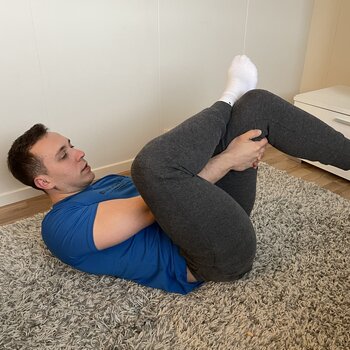Piriformis Stretch: 6 Best Stretches for Piriformis Syndrome
In this article, I’ll show you the best way to stretch piriformis muscle to relieve butt pain and numbness, as well as increase hip and lower back mobility.
These stretches are simple and effective, and can be done anywhere, without any stretching equipment.
Seated Piriformis Stretch
Sit on a chair and cross your legs so that your ankle is resting on the opposite thigh.
Slowly lean forward until you feel a comfortable stretch in your buttocks.
Hold this position for 30 seconds.
Supine Piriformis Stretch
This basic piriformis stretch is done by lying on your back and pulling one knee towards the opposite shoulder with your hands.
Try to keep your buttocks on the ground as you do this, as it will increase the stretch in the piriformis muscle.
Hold this position for 30 seconds.
Standing Piriformis Stretch Against Wall
Stand next to a wall and place one hand on the wall for balance.
Cross one leg over the other to create a figure-four position.
Then, slowly lean forward towards the wall. Hold this position for 30 seconds.
Ankle over Knee Piriformis Stretch
Lie on your back and cross one ankle over the opposite knee.
Then, use your hands to pull the leg that is on the ground towards your chest, feeling the stretch in your hip and buttocks.
Hold this position for 30 seconds.
Leg Crossover Piriformis Stretch
Lie on your back and lift one leg up in the air, bending it at the knee.
Then, cross that leg over to the opposite side of your body and hold the stretch for 30 seconds.
Advanced Piriformis Stretch With PNF Stretching Technique
Now I will show you an advanced stretch for the piriformis muscle.
The stretching technique is called proprioceptive neuromuscular facilitation, or PNF for short.
Follow these steps for the best stretching effect:
- Lie on your back, wrap one knee with both hands, and pull the knee towards the opposite shoulder. Hold in that position for 15 seconds. (blue)
- Then tighten the piriformis muscle by trying to straighten your leg, but don’t let your leg move with your hands (static muscle activation). Hold for 6 seconds in that position. (green)
- After that, continue with static stretching of the piriformis for another 15 seconds.
- Repeat the whole process 5 times, each time going deeper into the stretch.
How to Warm-up before Stretching Piriformis
Before stretching the piriformis, it is important to warm up with stretching and light cardio exercises such as walking, lateral walking, squats, or lunges in the morning and evening.
The warm-up should not last longer than ten minutes.
How Often Should You Stretch Piriformis?
You should aim to stretch your piriformis daily, and you can expect to see the effects of stretching after six weeks. For each exercise, you should hold the static stretch for 30 seconds.
Tips When Stretching Piriformis
When stretching and contracting your piriformis, it is important to pay attention to the following:
- Breathe deeply and avoid sudden movements in the hip and lower back.
- Stay within a comfortable range of motion and avoid overstretching the muscle.
- Hold the stretch or contraction in the piriformis for a comfortable amount of time and avoid holding it statically for too long.
- Never stretch your piriformis statically before strength training.
By following these guidelines, you can help prevent injury and get the most out of your piriformis stretching and strengthening exercises.
Benefits of Stretching a Piriformis
Stretching your piriformis can improve your hip mobility and flexibility, making it easier to move during activities such as walking, running, and climbing stairs.
It can also help relieve pressure on the sciatic nerve and reduce symptoms like pain and numbness in the gluteal region and down the leg.
What Other Hip Muscles You Should Stretch Beside Piriformis?
In addition to the piriformis, it is important to stretch the other muscles in the hip joint region, such as the gluteus maximus, medius, and minimus, tensor fasciae latae, hamstrings, and adductors.
Stretching all of these muscles together can have the greatest effect on improving hip joint flexibility.
So, make sure to include stretches for all of these muscles in your routine for optimal results. Check out stretching guides in this stretching book.
What is Piriformis Syndrome?
Piriformis syndrome is a condition in which the piriformis muscle, located in the buttock region, compresses the sciatic nerve, causing pain, numbness, tingling, and/or weakness in the buttocks and down the leg.
This can mimic the symptoms of sciatica, which is why piriformis syndrome is sometimes called “pseudo-sciatica.”
The condition can be caused by overuse or injury to the piriformis muscle, or by anatomical variations in the muscle’s position or shape.
Treatment options include stretching and strengthening exercises, physical therapy, medications, and in severe cases, surgery.
Should You Exercise with Piriformis Syndrome?
That’s right, you should. It’s important to stay active and do stretching and strengthening exercises for the piriformis muscle.
The spine also loves mobility, and if you’re inactive, there’s a greater chance of developing piriformis syndrome, which can become a chronic condition.
What Exercises to Avoid If You Have Piriformis Syndrome?
Avoid exercises that require you to sit for extended periods of time, such as cycling, and limit the time you spend sitting during the day. Also, try to avoid lifting heavy weights from the ground.
What Exercises Can You Combine with Piriformis Stretches?
You can also combine strength exercises for core and lower body, especially for the hip rotators and extensors.
These exercises include lateral squats, clamshells, hip extensions, and abductions in standing and side-lying positions.
Additionally, you should do light cardio exercises such as walking or running.





